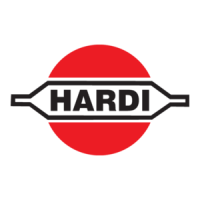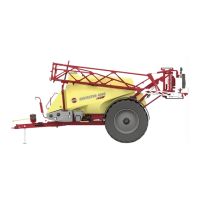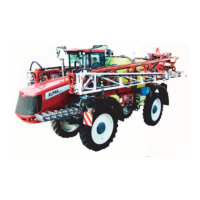5 - Operation
96
Rinsing When MainTank Is Not Empty
Rinsing the pump, operating units, spray lines, etc. in case of stop in spraying (e.g. because of rain), before MainTank is empty.
Cleaning of the liquid system:
1. Turn the suction valve towards . (Keep the pressure valve in -position). Close the self-cleaning filter, if possible.
2. Close the agitation valve (no agitation).
3. To prevent diluting the tank content, close the rinsing hose for the self-cleaning filter.
4. Engage the pump. Set the pump speed to approximately 300 RPM and increase the spraying pressure to 6 bar. Spray
the water from the RinseTank(s) into the field, until all nozzle tubes and nozzles have been flushed with clean water.
5. Turn Off the pump.
μ
ATTENTION! It is advisable to increase the forward speed (double, if possible) and reduce the spraying pressure to 1.5
bar, when spraying diluted remaining liquid in the field just sprayed.
Cleaning the Sprayer on the Outside
μ
ATTENTION! External cleaning using the spray gun is only possible with water from the RinseTank, which have been
directed through the MainTank. To avoid cleaning the sprayer on the outside using concentrated chemical mix from
the MainTank, do a complete MainTank cleaning before attempting to use the spray gun!
Refer to “Outside Cleaning - Use of External Cleaning Device” on page 129 for detailed procedure.
μ
ATTENTION! If the sprayer is cleaned with a high pressure washer, lubrication of the entire machine is recommended.
Use of Cleaning Agents
Recommended is to use an appropriate cleaning agent suitable for cleaning agricultural sprayers.
• Recommended is cleaning agents containing a suitable lube or conditioner.
• If for some reasons not available, and instead using triple ammonia water, it is important to rinse the liquid system
immediately after, and add some lubricant to the rinsing water to prevent ball valves etc. seizing up.
• Use of automotive antifreeze/radiator coolant (ethylene glycol) will protect valves and seals from drying or seizing up.
Using the Drain Valve
The drain valve is operated from the right side of the sprayer’s front.
1. Pull the string to open the drain valve.
2. The valve is spring-loaded, but can be kept open by pulling the
string upwards in the V-shaped slit.
3. To release, pull the string downward and the valve will close
automatically.
If draining residues, e.g. liquid fertilizer into a reservoir, a snap coupler
with hose can rapidly be connected to the drain valve, and the liquid is
safely drained.
